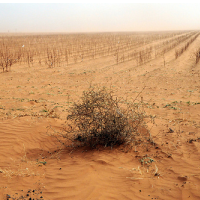Floods and Drought? NOAA Says Get Used to It
 Drought in Texas (photo: myweathertech.com)
Drought in Texas (photo: myweathertech.com)
The spring of 2013 is predicted to be dominated by drought, heat and flooding. The drought of 2012, which covered 65% of the continental U.S. and cost more than $50 billion in damage (more than Hurricane Sandy), is expected to persist in 2013, according to the annual spring weather outlook released last week by the National Oceanic and Atmospheric Administration (NOAA), an agency of the Department of Commerce. At present, about 51% of the continental U.S. is covered by drought.
The forecast predicts dry conditions again this year for much of the West, the Rockies, parts of the Southwest, most of Texas, the Gulf Coast and Florida, and wet conditions only in the Great Lakes and Ohio Valley regions. Only Hawaii has an enhanced chance of being cooler and drier than normal.
Making drought conditions even worse, NOAA predicts hotter than usual temperatures across most of the continental U.S. and northern Alaska, with below-normal temperatures predicted only for the Pacific Northwest and northern Great Plains. Last year was the hottest year since recordkeeping began more than 100 years, with several weeks in a row of 100-plus-degree days and high temperature records shattered across the country.
Yet there will be water—just not where we want it. In addition to minor to moderate flooding in the upper Mississippi River basin, on the Milk River in Montana, the Big Sioux River in South Dakota and the Little Sioux River in Iowa, NOAA predicts moderate and major flooding on the Red River of the North and the Souris River in North Dakota. Devils and Stump Lakes in North Dakota have a 50 percent chance of rising about two feet, which would flood 20,000 acres of farmland.
Calling the outlook “a mixed bag of flooding, drought and warm weather,” Laura Furgione, deputy director of NOAA’s National Weather Service, said “this outlook reminds us of the climate diversity and weather extremes we experience in North America, where one state prepares for flooding while neighboring states are parched, with no drought relief in sight.”
“The drought that we accumulated over the last five or six years in the middle part of the country and also the south-west is going to take a long time to remove,” explained Furgione. “The deficits in the soil [are] very enlarged, and it is very unlikely the seasonal mean precipitation will ameliorate that.”
-Matt Bewig
To Learn More:
NOAA Predicts Mixed Bag of Drought, Flooding and Warm Weather for Spring (NOAA press release)
Drought that Ravaged US Crops likely to Worsen in 2013, Forecast Warns (by Suzanne Goldenberg, Center for Investigative Reporting)
Every U.S. State Now Hit by Drought Conditions (by Noel Brinkerhoff, AllGov)
Most Widespread U.S. Drought in 24 Years (by Matt Bewig, AllGov)
- Top Stories
- Unusual News
- Where is the Money Going?
- Controversies
- U.S. and the World
- Appointments and Resignations
- Latest News
- Musk and Trump Fire Members of Congress
- Trump Calls for Violent Street Demonstrations Against Himself
- Trump Changes Name of Republican Party
- The 2024 Election By the Numbers
- Bashar al-Assad—The Fall of a Rabid AntiSemite






Comments